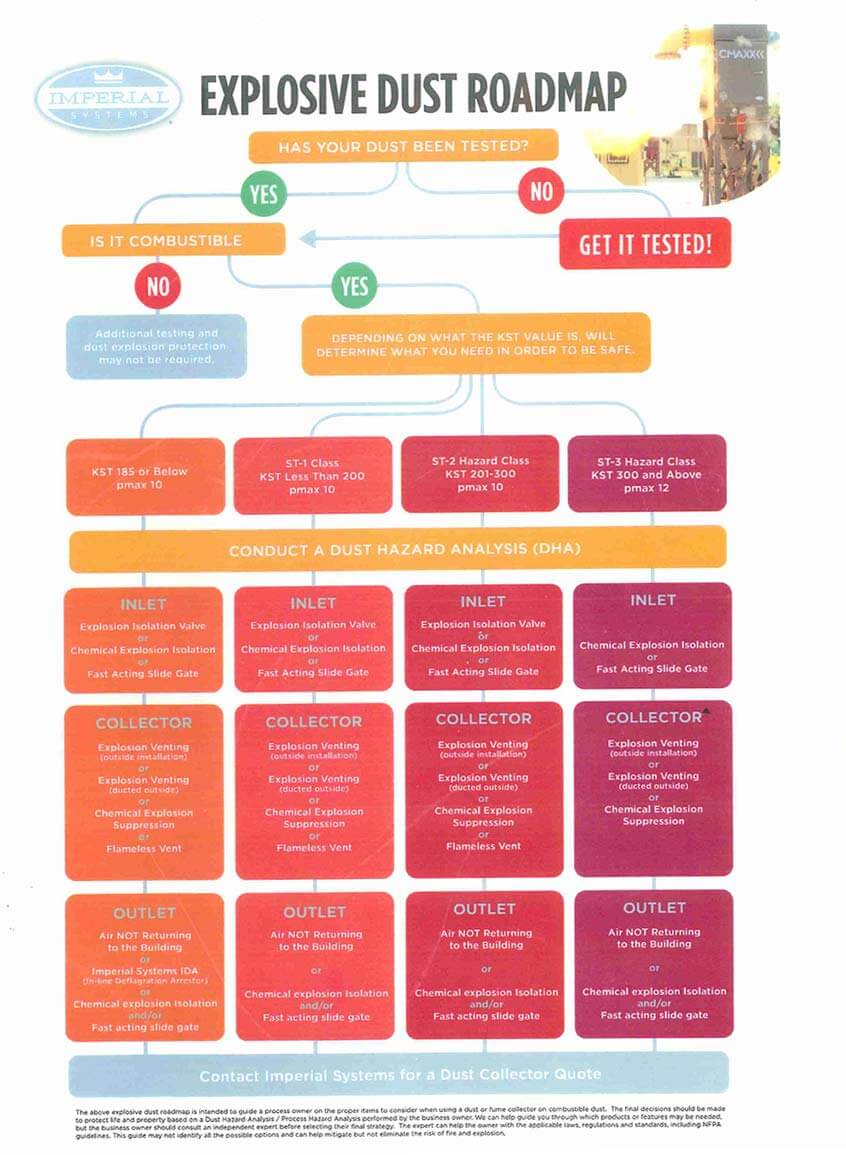Combustible Dust
Glacier Technology Combustible Dust Questionnaire
Do You Have Combustible Dust in Your Facility?
Almost all organic dust is combustible. Grain handling facilities deal with frequent dust explosions. Many metal dusts are also combustible, and metal dust fires can be very difficult to extinguish.
The best and only way to know for certain if your dust is combustible is to have dust testing done to verify the material properties. If your dust is combustible, you need to have a dependable combustible dust system in place.
Filtering Dust is Expensive! Save Up to 25% with Patented IDA DeltaMAXX Technology
Glacier Technology works with CMAXX to provide effective and affordable solutions for combustible dust control. The CMAXX combined with proprietary IDA (In-Line Deflagration Arrester) DeltaMAXX filters an efficient and proven solution for isolating a deflagration and stopping a flame front. Combining the CMAXX with IDA DeltaMAXX filters eliminates the need for expensive after filters.
Four Steps to a Combustible Dust Solution
Glacier Technology develops combustible dust solutions in 4 steps:
- Determine if dust is combustible. If any of the particles produced in your process can burn, chances are it is a combustible dust.
- Dust Hazard Analysis (DHA). DHA of the dust provides a Kst value, the measurement used to indicate how likely a dust is to explode. This value helps determine your dust collector needs.
- Determine best placement. Depending on your facility and process, your dust collector can be installed inside or outside of the building.
- Select Accessories. Our team helps you select the best explosion and fire mitigation accessories to optimize the safety of your system, including proactive and reactive combustible dust solutions.
Glacier Technology can guide you with the right questions to ask. We can also help examine current dust collection systems to help determine if they are in compliance with the most recent NFPA standards. During the visit we will discuss dust control measures, explosion prevention measures, and explosion protection measures. We can also put you in contact with testing facilities capable of analyzing your dust.
Contact Glacier Technology today to schedule an onsite visit.
NOTE: Existing collection systems are not grandfathered in under previous standard and do not have any retroactive immunity. They must be brought into compliance with current standards and the price of keeping them in compliance is eternal vigilance.
- Explosive Dust Roadmap
- Compliance
- NFPA
- Proactive vs Reactive
- CMAXX and IDA
- Video
- Rhino Drum
Compliance
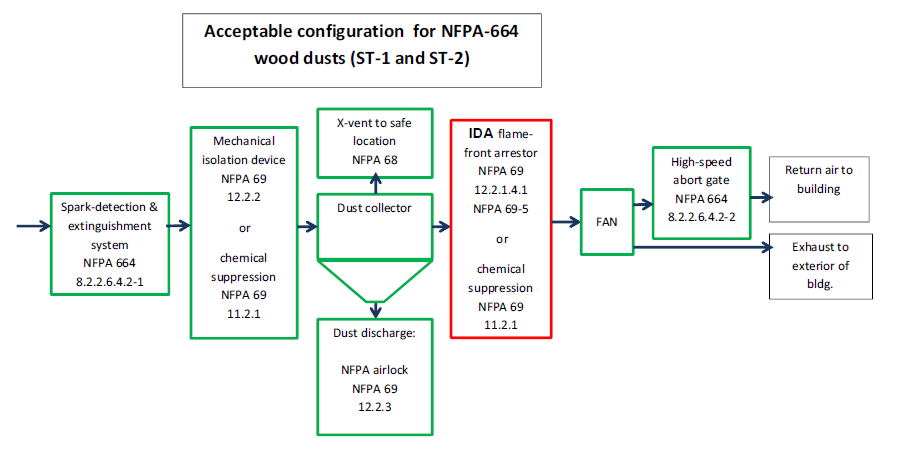
- The NFPA (National Fire Protection Association) has set numerous codes and standards relating to prevention of fire and dust explosions from the manufacturing processing and handling of dusts.
- OSHA enforces the standards published by NFPA under their General Duty Clause. Two of the most common violations are 1) accumulation of combustible dust in workplaces and 2) failure to perform a Process Hazard Analysis and Risk Assessment.
Failure to have proper documentation on how hazardous a dust may be is one of the most common oversights. NFPA Standards tab
NFPA
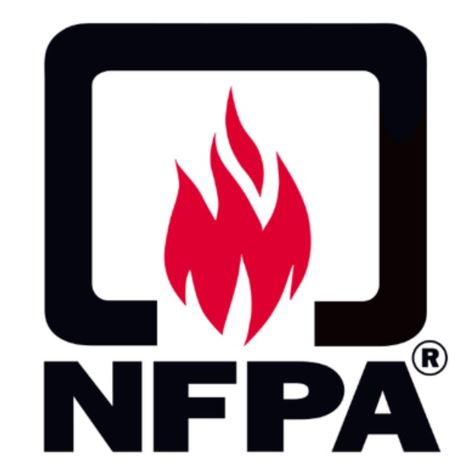
NFPA 654
- Standard for Prevention of Fire and Dust Explosions from the Manufacturing, Processing, and Handling of Combustible Particulate Solids.
- Most general document on how to design a safe dust collection system.
- Defines requirements for a Process Hazard Analysis and Risk Assessment.
- Directs readers to many other relevant documents and more specific NFPA standards.
NFPA 68
- Standard for Explosion Protection by Deflagration Venting.
- Contains design requirements and calculations for devices that vent pressures resulting from a deflagration in a dust collector.
- Intended to minimize structural and mechanical damage to equipment if a deflagration even should happen.
NFPA 69
- Standard on Explosion Prevention Systems.
- Prescribes the design of preventions controls for dust collection systems.
- Prevention Controls include Isolation and Suppression devices.
NFPA 484
- Standard for Combustible Metals.
- Outlines the procedures to determine whether a metal is in combustible form or not.
- Prescribes specific controls relating to metal dust due to the severity of explosions and the relative ease of ignition.
- Aluminum and Magnesium have specific requirements for dry dust collection.
- Standard for Prevention of Fires and Explosions in Wood Processing and Woodworking Facilities.
- Prescribes specific controls relating to wood dust, because of the tendency of wood processing equipment to create sparks and start fires.
NFPA 61
- Standard for Prevention of Fires and Dust Explosions in Agricultural and Food Processing Facilities.
Prescribes specific controls relating to food industry, due to the large variety of combustible dusts and bulk material in food processing facilities. Such as grains, sugar, flour, feeds, and spices.
Proactive vs Reactive
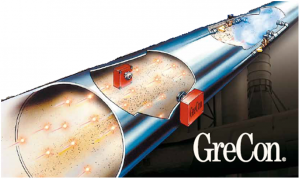 NFPA compliant dust collector accessories could be divided into two main categories: proactive and reactive combustible dust solutions. Proactive devices work to prevent or reduce the likelihood of a deflagration event. Reactive devices are designed to minimize injury to personnel, limit damage to equipment and property, and avoid projectile hazards. in the event of a deflagration.
NFPA compliant dust collector accessories could be divided into two main categories: proactive and reactive combustible dust solutions. Proactive devices work to prevent or reduce the likelihood of a deflagration event. Reactive devices are designed to minimize injury to personnel, limit damage to equipment and property, and avoid projectile hazards. in the event of a deflagration.
Most of the NFPA prescriptive based designs deal with reactive devices assuming that a deflagration event will eventually happen and what can be done to mitigate the damage of the incident.
CMAXX and IDA
IDA (In-Line Deflagration Arrester)
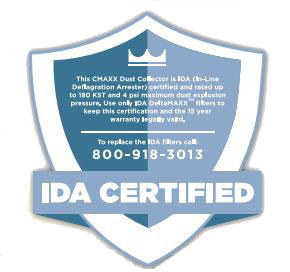 The CMAXX and the proprietary IDA (In-Line Deflagration Arrester) DeltaMAXX filters have been proven by third-party testing to isolate a deflagration and stop a flame front. (Reports and test results can be provided upon request.)
The CMAXX and the proprietary IDA (In-Line Deflagration Arrester) DeltaMAXX filters have been proven by third-party testing to isolate a deflagration and stop a flame front. (Reports and test results can be provided upon request.)
Other systems have been tested, but all require additional after filters. Combining the CMAXX with IDA DeltaMAXX filters eliminates the need for expensive after filters that can prematurely blind, causing issues including:
- High pressure drop
- Increased filter expenses
- Additional labor to install
- Decreased headroom for indoor applications
- Enlarged filter housings
- Filters consistently cleaned during operation
Video
Combustible Dust – Explosion Protection
Rhino Drum
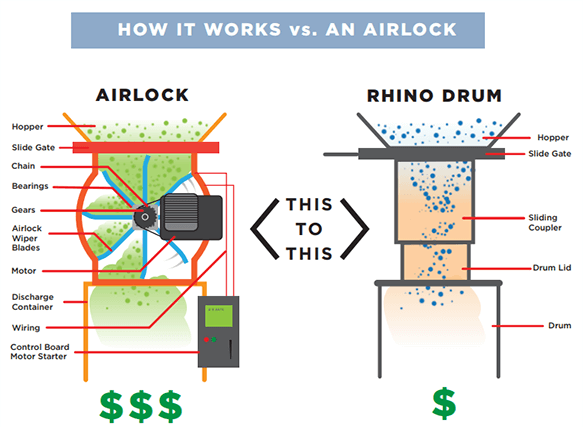 Rhino Drum Explosion Tested Drum Kit (ETDK)
Rhino Drum Explosion Tested Drum Kit (ETDK)
First and Only 3rd Party Explosion Tested Drum Kit
- Simple and Proven Design
- Explosion Tested to 7psi
- Meets Standards for NFPA 69/654
- Optional Grounding
- No Moving Parts
- No Flex Hose
Eliminates need for Airlock – Half the Cost!
No need for:
- Wiring
- Maintenance
- Motor
- Starter
- Wipers
- Chains


